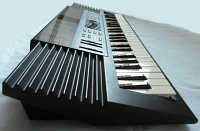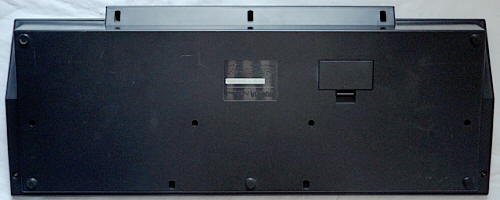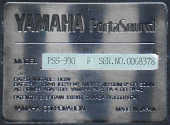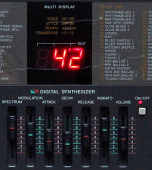 |
 |
This is definitely one of the most exciting Yamaha PortaSound keyboards, because this instrument from 1990 features an FM synthesizer that is controlled in a very simplified way through 7 sliders.
 |
 |
FM synthesis is particularly well suited to simulate brass wind instruments, picked strings and metal percussion, but it can also make great electronic organ sounds and lots of freaky bass synth noises. Despite the FM sound generator of this keyboard seems to be technically extremely similar like the one of the Fujitone 6A, the preset sounds are very different. While my 6A has very warm, but rather unnatural programmed timbres, the presets of the PSS-390 sound much more natural, but also colder (likely because a higher modulation level was used to create more overtones but less bass). The PSS-390 also pans sounds in stereo while the 6A is mono. Very interesting is that these instruments use a higher developed FM synthesis engine with more versatile sounds than the more expensive semi- professional MIDI PortaSound keyboards (e.g. my PSS-780), which makes it less easy to answer which PortaSound is "the best".
A unique feature of FM is that (particular in "sustain" mode) the timbre of notes changes depending on how long keys are pressed; thus despite the keyboard is not velocity sensitive, this "duration sensitive" play provides a relatively expressive playability that is far beyond modern sample based instruments without velocity sensitive keyboard. This instrument can also simulate well certain high and creaky distorted C64 SID tones (those used ring modulation?) known from Rob Hubbard's compositions, but it can not simulate well plain squarewave tones over multiple octaves, because depending on the modulation intensity either the low notes become way too dull or the trebles become too harsh (because this simple FM uses multiplied sine(?) waves those can not result in a sufficiently steep square waveform).
 |
 |
 |
 The
PSS-390 (also my Fujitone 6A) uses 4 operators for many of its sounds (i.e.
quasi 2 internally layered 2 op sounds =>half polyphony but more realistic/
thicker, which permits e.g. a reasonable sounding human voice "female chorus"),
and it has many wild noise presets with complex pitch LFO, arpeggiator
and retrigger effects (e.g. ringing "mandolin", "telephone", "helicopter",
"machine gun", gritty and fat "brass ensemble", arpeggios in "crystal",
"comet" etc., lots of great siren- like howling stuff like "ufo" or "ghost"),
which I always expected to be standard with Yamaha FM instruments. But
when I later bought the semi- professional Yamaha PSS-780 (the most
advanced and most versatile top of the line FM PortaSound that was ever
made - with MIDI, 61 keys, pitchbend wheel, 8 drumpads, sequencer etc.),
I had to discover that this one includes none of these great effects but
uses only very plain 2 operator FM for any sounds (although with a few
more parameters), and it contains also no funny noise presets (like "helicopter").
I also downloaded manuals of other MIDI PortaSounds with FM synthesizer,
and they all lack these great effects. Possibly Yamaha feared here to confuse
customers with too many editable parameters, but they could have simply
kept them uneditable as already some other parameters are. Possibly also
the complex LFO and envelope effects would have disturbed the delicate
timing of MIDI transmission because they are likely generated by the main
CPU and not controlled by the sound chip itself. There is also no FM PortaSound
with MIDI and synth sliders. With the PSS-390 particularly the noise effect
presets can be easily tweaked into the most fantastic and bizarre tekkno
sounds, and since these off all don't exist in the "professional" MIDI
PortaSounds, it is difficult to rate which FM PortaSound is the best or
most versatile instrument.
The
PSS-390 (also my Fujitone 6A) uses 4 operators for many of its sounds (i.e.
quasi 2 internally layered 2 op sounds =>half polyphony but more realistic/
thicker, which permits e.g. a reasonable sounding human voice "female chorus"),
and it has many wild noise presets with complex pitch LFO, arpeggiator
and retrigger effects (e.g. ringing "mandolin", "telephone", "helicopter",
"machine gun", gritty and fat "brass ensemble", arpeggios in "crystal",
"comet" etc., lots of great siren- like howling stuff like "ufo" or "ghost"),
which I always expected to be standard with Yamaha FM instruments. But
when I later bought the semi- professional Yamaha PSS-780 (the most
advanced and most versatile top of the line FM PortaSound that was ever
made - with MIDI, 61 keys, pitchbend wheel, 8 drumpads, sequencer etc.),
I had to discover that this one includes none of these great effects but
uses only very plain 2 operator FM for any sounds (although with a few
more parameters), and it contains also no funny noise presets (like "helicopter").
I also downloaded manuals of other MIDI PortaSounds with FM synthesizer,
and they all lack these great effects. Possibly Yamaha feared here to confuse
customers with too many editable parameters, but they could have simply
kept them uneditable as already some other parameters are. Possibly also
the complex LFO and envelope effects would have disturbed the delicate
timing of MIDI transmission because they are likely generated by the main
CPU and not controlled by the sound chip itself. There is also no FM PortaSound
with MIDI and synth sliders. With the PSS-390 particularly the noise effect
presets can be easily tweaked into the most fantastic and bizarre tekkno
sounds, and since these off all don't exist in the "professional" MIDI
PortaSounds, it is difficult to rate which FM PortaSound is the best or
most versatile instrument.
Despite lots of great sounds, the PSS-390 is not a perfect versatile synthesizer but has many limitations, but some of them are not necessarily bad and may make it especially great for tekkno. E.g. the sliders provide only control over 7 selected parameters in a limited range, and these only in a very coarse 8 step resolution that is not really adequate to control a complex FM synthesis; especially with "modulation" would be even a 64 step resolution (present in many common FM synths) still quite coarse. Thus timbres you get out of it sound often rather harsh and thin at one setting, but too muffled as soon you reduce spectrum or modulation by only 1 step. Even worse, the sliders are not fully realtime, but they update the sound only with about 5 Hz, thus when you move them slowly, you hear all steps in between as gritty zipper noise, but when you move them fast, the heard sound skips the steps. There is also no way to save synthesizer settings, but it takes only a row of 9..10 numbers to write them down. My modified Fujitone 6A can make even wilder FM noises than the PSS-390, but its DIP switches are way less intuitive to use and no replacement for easily predictable behaving realtime sliders. (I haven't analyzed this hardware, but saw schematics photos.)
When the instrument is switched on, it starts always in dual voice mode with both voices selecting "piano". This adds a chorus effect to the piano but reduces polyphony to 4 notes. This piano also has the typical unrealistic dull bass section known from most cheap FM keyboards. To get a better piano sound, select "harpsichord" and set spectrum=8 and modulation=2 on the synthesizer. The makes a less harsh version of the harpsichord which sounds very similar like the piano sound of my Yamaha PSS-780 =>you get a piano with realistic bass and can play up to 9 note polyphonic when dual voice is off. Otherwise dual voice is a great feature, because it can create very fat and bassy sounds roaring with up to 8 operators when 2 different 4 operator sounds are layered.
The value of the accompaniment section of the PSS-390 is one of the most questionable and difficult to rate things. At the one hand there are 100 very richly and wonderfully orchestrated styles available with each 2 fill- ins and an ending, and they can be very inspiring and a lot of fun to improvise to and play around with. At the other hand (like with all later PortaSound keyboards) the accompaniment reacts only strictly on what some snobbish establishment music academics have defined to be "chords" , i.e. even in "fingered chord" mode you can not force the accompaniment to play any other notes or note combinations, because this stubborn final automaton simply completely ignores any other key combination and behaves like when no accompaniment keys were pressed at all (i.e. it continues playing the previous chord). I conclude that this style bank algorithm recognizes chords and then transposes out of a hand full of pre- written note sequences a corresponding one for each known chord from its ROM library to play it. This should possibly enable it to add some small "human touch" fill- ins with certain chord changes, but when no known chords are played, this stubborn silly thing is totally blind and can do nothing. A reasonable accompaniment algorithm should instead count the number of pressed keys in the accompaniment section and simply play the notes of these keys at the correct time, no matter which keys they are and if their notes form a chord or not. Casio could do this already in its very first automatic accompaniments, old Yamaha keyboards did this too, and my Testron keyboard is a good example how versatile such a plain accompaniment algorithm can sound. Even my Fujitone 6A is clever enough to play non- chords and single notes by its automatic accompaniment. But with this stupid modern Yamaha style bank you can only play always chord with the full number of notes, and this is particular annoying since the 100 preset styles are (although nice) quite over- orchestrated and over- specialized; most of them are black music (jazz, blues, funk, reggae etc.) or classical music and also the rest has strong tendencies to sound this way. Can you imagine, there is e.g. no plain waltz or tango - there is just a baroque waltz, a jazz waltz and 2 tangos with both a chinking Venetian mandolin or marimba arpeggio in the background. I have nothing really against them - all these styles are cute, but they are in no way versatile, and you can not even omit some notes by pressing less or no keys. Thus you can turn accompaniment off or switch it to "auto bass" mode, in which all non- chords in the left keyboard section are played in a voice corresponding to the selected style (sort-of key split), while chords are recognized and accompanied by bass notes of the style. When rhythm is stopped, the accompaniment section plays continuous chord and/ or bass tones with a timbre corresponding to the selected style. But another annoying flaw is that any notes played through the accompaniment section (i.e. also manual bass) stay always within the same octave, no matter if you press keys in the lowest or 2nd lowest keyboard octave to play them. This makes it impossible to play very low and higher bass notes (or chords) like a real key split mode should do.
The demo music is a well known and nicely arranged latin/ fusion music track that reminds to the FM sound track of Sega's great classic arcade game "Outrun" from 1986.
Fortunately the Yamaha PSS-390/ PSS-380 is not rare and easy to find at eBay. A simpler version of it (without digital synthesizer, only 25 styles, chord memory instead of sequencer) with a very similar case was released as Yamaha PSS-290/ PSS-280/ PSS-26 (has internal ROM, seen in schematics photos).
Predecessor of Yamaha PSS-390 was the PSS-460/ PSS-470;
there also was a smaller mono version
PSS-360/ PSS-370. These
keyboards from 1986..1987 had a programmable drum pattern ("custom drummer"),
separate chord and rhythm volume sliders, 2 chord and bass variations,
"stereo symphonic" and "duet" feature, but way less preset sounds and styles.
At eBay these were sometimes sold for stupidly high prices (possibly
bidders confuse them with real analogue synths due to the many sliders)
although the digital synthesizer sliders of these cucumbers had even only
5 steps and thus were
worse than the PSS-390. I don't own one and
don't know if their accompaniment worked better than the stubborn modern
"style bank", but I think so, because I bought later a PSS-570,
which is very much like the PSS-470 (but without any programmable sequencer
features), and its accompaniment can indeed play non- chords and its primitive
FM synthesizer can be even assigned to the bass and/ or chord sounds (that's
interesting). But it has none of the great howl and siren effects of the
PSS-390, and its timbres are only very plain 2 operator FM with simple
attack- decay envelopes (i.e. neither ringing mandolins nor any pitch envelope
effects), and its synth also does not use the sound presets as templates,
but instead has a 6th "wave" slider to select from only 5 basic timbres.
| removal of these screws voids warranty... | ||
 |
||
|
|